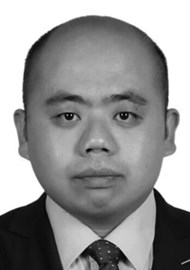For many of us all around the world, art is a form of storytelling, whether we link it to our work, our hobbies or our dreams.
As a teenager growing up in the 90s, I loved ballet in high school. The excitement for my final year in Theatre Drama was a nightlight art dance! I proudly studied a combination of fine arts and drama in after-school theatre performances. An amazing experience, from creating silk coloured fabric butterfly wings to drawing art on human bodies, who then twirled to composed music in dramatic theatre lights to scripts written by our talented teachers.
With a similar artistic vibe, I was extremely honoured and privileged to hear from Professor Ningli Wang in Beijing, China. Prof Wang is an Ophthalmologist with an artistic dream and has been exploring the combination of science and art.

眼睛的良心 – The conscience of the eye. This shows the glaucoma doctor, with a searchlight, paddling in turbulent water to protect the aqueous humor outflow pathway. Just as Victor Hugo said that the sewer is “the conscience of the city”, the outflow channel of the aqueous humor is also like “the conscience of the eye”. It ensures the smooth passage of the aqueous humor that can balance the intraocular pressure.

走钢丝的人 – A tightrope walker. This shows the doctor holding a device to symbolise the superb skill of microscopic operation under endoscope. The pulled-up film represents the proliferative membrane in front of the retina in the macula.

太极之跨筛板之战 – The Great Ultimate: the war of the laminar cribrosa. This shows The Great Ultimate (Taiji) producing the two polarities (Yin and Yang). There are two magical forces on both sides of the lamina cribrosa: intraocular pressure and cranial pressure. Just like Taiji, only when they maintain balance, can the optic nerve be protected from damage.
The 500th anniversary of Leonard da Vinci’s death in 2019 marked a remarkable opportunity for Prof Wang and his team to translate and publish the book Leonard Da Vinci Anatomist. The exquisite anatomical manuscripts and Da Vinci’s spirit of exploring the unknown human body inspired Prof Wang to create his own works of medical art.
Prof Wang also admired the surreal artworks of art master Emil G Bethke, whose form of expression integrated the eye structure with humanity and nature. This encouraged Prof Wang to new directions in ‘artistic expression’.
In one year, Prof Wang and his creative team completed a series of digital art paintings combining ophthalmology with art. Based on many years of clinical research experience and with the help of designer Tian Ning, surrealistic art paintings were created on the theme of ‘eyes’.
This article explores just three of these pieces. These fine prestige pieces of art combine anatomical structure, pathological manifestations and surgical approaches to the eyes with natural scenery and characters.
Acknowledgement: The authors would like to thank: Ye Chen, Yuan Xie, Mayinuer Yusufu, Huimin Yang, Yifan Du, Jiaxin Tian, Yikang Tao, Yue Zhang and Rong Du.
Comments are welcome







